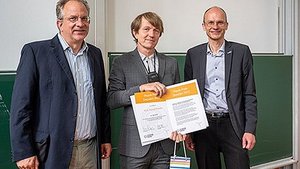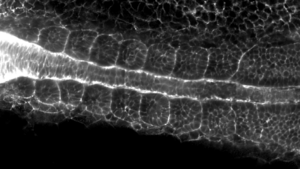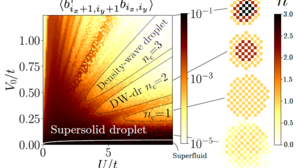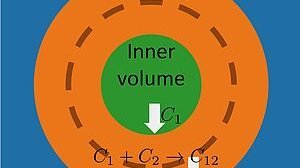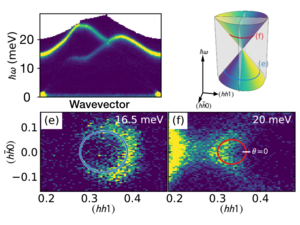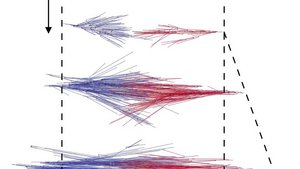Highlights
Awards and Honors
"Physik-Preis Dresden 2022" awarded to Professor Tomaž Prosen
On May 24, 2022, Prof. Tomaž Prosen from the University of Ljubljana in Slovenia received the "Physik-Preis Dresden" (Dresden Physics Prize), jointly awarded by the TU Dresden and the Max Planck Institute for the Physics of Complex Systems (MPI-PKS). The theoretical physicist receives the award for his outstanding work on quantum mechanical many-body systems, nonequilibrium statistical physics, quantum information, classical chaos and quantum chaos.
Tomaž Prosen has authored over 200 publications on this broad range of topics, which have over 7000 citations and are recognized in expert circles worldwide. In 2016, he received a prestigious ERC Advanced Grant. The award ceremony took place at a festive colloquium in the Recknagel Building of the TU Dresden, preceded by a reception. Prof. Carsten Timm, Dean of the Faculty of Physics, gave the welcome address, and Prof. Roderich Moessner of MPI-PKS delivered the laudation.
The Physik-Preis Dresden was endowed in 2015 by Dresden physicist Prof. Peter Fulde, the founding director of the MPI-PKS. The prize winners are determined by a joint commission of the TU Dresden and the MPI-PKS. In addition to the central criterion of scientific excellence, it is particularly important for the decision that the work of the award winners is of special significance for the cooperation between the two DRESDEN-concept partners MPI-PKS and TU Dresden and that their connection has been further strengthened in the long term. The 2022 awardee, Prof. Tomaž Prosen, has a wide range of connections to the professorships at the Institute for Theoretical Physics at TU Dresden and at MPI-PKS due to his broad scientific orientation.
weiterlesenPublication Highlights
Left-right symmetry of zebrafish embryos requires surface tension
Bilateral symmetry of the vertebrate musculoskeletal system is necessary for proper function and its defects are associated with debilitating conditions, such as scoliosis. In a collaboration with biologists from the École polytechnique fédérale de Lausanne (EPFL) in Switzerland, Marko Popović of the Max Planck Institute for Physics of Complex Systems has studied the early stage of body segmentation using zebrafish as a model organism. They discovered that biochemical signalling and transcriptional processes that drive segmentation are not sufficient to explain the precision and symmetry of tissue shapes and sizes. However, they found that surface tension forces of the newly formed segments are a crucial component of the mechanism that is responsible for recovery and maintenance of the symmetric body plan. This discovery highlights the importance of physical interactions for precise and robust development of living beings.
S. R. Naganthan, M. Popovic, and A. C. Oates, Nature 605, 516-521 (2022)
weiterlesenS. R. Naganthan, M. Popovic, and A. C. Oates, Nature 605, 516-521 (2022)
Institute's News
New Research Group: Transport and flows in complex environments
We cordially welcome Christina Kurzthaler at the institute! Christina joins MPI-PKS from Princeton University and establishes the research group "Transport and flows in complex environments“. The group aims to unravel physical phenomena arising in soft and active matter, with emphasis on the role of transport and flows for biological systems and microfluidics. Its research topics range from the hydrodynamics of swimming bacteria and their interactions with their environments to the statistical physics of active transport in porous materials to the motion of colloidal suspensions in microfluidic settings. While the group's work is theoretical, it seeks to establish collaborations with experimentalists of the Dresden research community.
weiterlesenPublication Highlights
Novel quantum phases of droplets
Attractive forces are ubiquitous in nature: they glue very different objects ranging from atomic nuclei, droplets of water, to stars, galaxies, and black holes. Peter Karpov and Francesco Piazza of the Max Planck Institute for the Physics of Complex Systems have now demonstrated that highly tuneable attractive interactions can be engineered artificially using optical cavities, leading to various novel phases of quantum droplets of ultracold atoms. Upon tuning the cavity-mediated interactions it is possible to switch between superfluid droplets and incompressible water-like droplets, as well as to realise crystalline and even more exotic supersolid droplets combining superfluid and solid properties.
P. Karpov and F. Piazza, Phys. Rev. Lett. 128, 103201 (2022)
weiterlesenP. Karpov and F. Piazza, Phys. Rev. Lett. 128, 103201 (2022)
Publication Highlights
Molecular Assembly Lines in Active Droplets
A fundamental question in biology is how complexes of several molecules can assemble reliably. Tyler Harmon and Frank Jülicher of the Max Planck Institute for the Physics of Complex Systems have now shown that a molecular assembly line can be self-organized by active droplets where it can form spontaneously. This assembly line arranges different assembly steps spatially so that a specific order of assembly is achieved and incorrect assembly is suppressed. They have shown how assembly bands are positioned and controlled and discuss the rate and fidelity of assembly as compared to other assembly scenarios.
T. S. Harmon and F. Jülicher, Phys. Rev. Lett. 128, 108102 (2022)
weiterlesenT. S. Harmon and F. Jülicher, Phys. Rev. Lett. 128, 108102 (2022)
Awards and Honors
Funding to understand emergent physical properties of chromatin using synthetic nuclei
ERC Consolidator Grant for Jan Brugués
Today, the European Research Council (ERC) announced the winners of its latest Consolidator Grant competition for ambitious mid-career researchers. Jan Brugués, research group leader both at the Max Planck Institute of Molecular Cell Biology and Genetics (MPI-CBG) and the Max Planck Institute for the Physics of Complex Systems (MPI-PKS) is one of the 313 laureates who were awarded the 2022 ERC Consolidator Grants. The funding is part of the EU’s Horizon Europe programme, and the winners will receive in total 632 million Euros to tackle big scientific questions. In total, 2,652 applicants submitted proposals and 12% of them will receive the funding. Male and female applicants were equally successful in winning the grants. The future grantees will carry out their projects at universities and research centers across 24 EU Member States and associated countries. This new round of grants will create an estimated 1,900 jobs for postdoctoral fellows, PhD students and other staff at 189 host institutions.
Jan receives the grant for his project “Understanding emergent physical properties of chromatin using synthetic nuclei.” The main goal of this project is to resolve how the physics of molecular-scale activities result in the material properties of chromatin and how those contribute to chromatin organization and function. Jan Brugués explains: “With my project, I hope to provide a physical description of the material state of chromatin across different scales and contribute to reveal the basic physical principles that govern nuclear organization and function.”
Congratulations Jan!
weiterlesenToday, the European Research Council (ERC) announced the winners of its latest Consolidator Grant competition for ambitious mid-career researchers. Jan Brugués, research group leader both at the Max Planck Institute of Molecular Cell Biology and Genetics (MPI-CBG) and the Max Planck Institute for the Physics of Complex Systems (MPI-PKS) is one of the 313 laureates who were awarded the 2022 ERC Consolidator Grants. The funding is part of the EU’s Horizon Europe programme, and the winners will receive in total 632 million Euros to tackle big scientific questions. In total, 2,652 applicants submitted proposals and 12% of them will receive the funding. Male and female applicants were equally successful in winning the grants. The future grantees will carry out their projects at universities and research centers across 24 EU Member States and associated countries. This new round of grants will create an estimated 1,900 jobs for postdoctoral fellows, PhD students and other staff at 189 host institutions.
Jan receives the grant for his project “Understanding emergent physical properties of chromatin using synthetic nuclei.” The main goal of this project is to resolve how the physics of molecular-scale activities result in the material properties of chromatin and how those contribute to chromatin organization and function. Jan Brugués explains: “With my project, I hope to provide a physical description of the material state of chromatin across different scales and contribute to reveal the basic physical principles that govern nuclear organization and function.”
Congratulations Jan!
Publication Highlights
Dirac Magnons, Nodal Lines, and Nodal Plane in Elemental Gadolinium
The exploration of band topology in crystalline solids has been at the forefront of condensed matter physics for many years in efforts tying together theoretical physics, materials science and powerful spectroscopic techniques. One relatively new avenue is the exploration of band topology in the spin wave, or magnon, excitations of magnetic materials. Spin wave topology is connected to novel magnetic transport properties, little explored symmetries and surface magnetism and offers a new platform to study interactions. One of the main current directions is to find new materials with topologically interesting band structures and this new study does exactly this by establishing the existence of Dirac nodal lines and a nodal plane in the magnons of elemental gadolinium.
Gadolinium is a hexagonal closed packed magnetic metal in which, at around room temperature, the magnetic moments order into a simple ferromagnetic structure. In this new study, a team of experimentalists at Oakridge National Lab in the US together with theory collaborators explored the magnetic excitations of gadolinium in the ordered phase in unprecedented detail using inelastic neutron scattering. They found that gadolinium hosts Dirac magnons in the form of nodal lines extending along the zone corners. The existence of the nodal lines can be seen to arise from the presence of combined spin rotation and crystalline symmetries providing a first experimental example of the importance of such symmetries for band topology. In the vicinity of the nodal lines, the neutron scattering intensity can be seen to wind around the lines from strong to weak and in antiphase between the two bands (as shown in the figure). This intensity signature is a robust prediction connected to the nontrivial topology of these points. From the existence of the nodal lines one may infer the existence of magnon surface states $-$ a challenging target for future experiments.
Furthermore, the nonsymmorphic crystal symmetries together with spin rotation enforce the presence of a degenerate plane of magnon excitations. Just as the nodal lines exhibit winding of the neutron intensity in their vicinity, the nodal plane is linked to a sharp flip in the intensity on paths crossing through the plane. Both the nodal plane and the intensity jump are clearly observed in the data.
Phys. Rev. Lett. 128, 097201 (2022)
weiterlesenGadolinium is a hexagonal closed packed magnetic metal in which, at around room temperature, the magnetic moments order into a simple ferromagnetic structure. In this new study, a team of experimentalists at Oakridge National Lab in the US together with theory collaborators explored the magnetic excitations of gadolinium in the ordered phase in unprecedented detail using inelastic neutron scattering. They found that gadolinium hosts Dirac magnons in the form of nodal lines extending along the zone corners. The existence of the nodal lines can be seen to arise from the presence of combined spin rotation and crystalline symmetries providing a first experimental example of the importance of such symmetries for band topology. In the vicinity of the nodal lines, the neutron scattering intensity can be seen to wind around the lines from strong to weak and in antiphase between the two bands (as shown in the figure). This intensity signature is a robust prediction connected to the nontrivial topology of these points. From the existence of the nodal lines one may infer the existence of magnon surface states $-$ a challenging target for future experiments.
Furthermore, the nonsymmorphic crystal symmetries together with spin rotation enforce the presence of a degenerate plane of magnon excitations. Just as the nodal lines exhibit winding of the neutron intensity in their vicinity, the nodal plane is linked to a sharp flip in the intensity on paths crossing through the plane. Both the nodal plane and the intensity jump are clearly observed in the data.
Phys. Rev. Lett. 128, 097201 (2022)
Institute's News
Emergency Fellowships for Scientists in Ukraine
We offer Emergency Fellowships to researchers at all career stages in Ukraine. Applications are considered continuously.
weiterlesenPublication Highlights
Flowing by gelating - gelation enables the correct architecture of the mitotic spindle.
In the cell, the mitotic spindle is a structure that forms during cell division and segregates the chromosomes into the two future daughter cells. Spindles are made of dynamic filaments called microtubules that are continuously transported towards the two opposite poles of the spindle by molecular motors. However, scientists still do not understand how these poleward flows are generated and how they lead to spindle self-organization.
Researchers in the group led by Jan Brugués at the Max Planck Institute of Molecular Cell Biology and Genetics (MPI-CBG), the Max Planck Institute for the Physics of Complex Systems (MPI-PKS) and the Center for Systems Biology Dresden (CSBD), worked together with Frank Jülicher’s research group at the MPI-PKS to understand how such poleward flows are generated in spindles. In 2018, the Brugués lab was able to show that the size of spindles is controlled by microtubule branching: In the vicinity of DNA, new microtubules branch off from mother microtubules like branches in a tree. However, such a branching process naturally leads to microtubules branching outwards from chromosomes, whereas in real spindles they branch inwards to interact with chromosomes during segregation.
In the current study, published in the journal Nature Physics, the scientists combined in vitro experiments with physical models to show that the poleward flows together with a gelation process driven by motor crosslinking, allows for the correct microtubule inward branching observed in spindles. Benjamin Dalton an author in the study, explains, “The spindle is a highly dynamic structure where its building blocks are constantly created, transported and destroyed within seconds. Still, the spindle can survive for as long as an hour and the microtubule flows are remarkably constant throughout the structure. It’s difficult to reconcile these things.” David Oriola, another author in the study explains, “By tracking the movement of single microtubules using fluorescent microscopy, we found that the spindle did not behave as a simple fluid, but rather as a gel.” Combining large-scale simulations with experimental data, the researchers found that gelation is necessary for the generation of the poleward flows, and in turn, such flows are in charge of organizing the microtubule network such that microtubules point inwards rather than outwards.
Dalton et al.: A gelation transition enables the self-organization of bipolar metaphase spindles. Nature Physics, 10 February 2022, doi: 10.1038/s41567-021-01467-x
weiterlesenDalton et al.: A gelation transition enables the self-organization of bipolar metaphase spindles. Nature Physics, 10 February 2022, doi: 10.1038/s41567-021-01467-x
Awards and Honors
Artificial intelligence and stochastic models to guide personalized cancer therapy
Steffen Rulands receives funding within the REDESIGN consortium to bring personalized cancer therapy to patients using organoids and predictive models.
The Saxon Ministry for Science, Arts and Tourism is funding four research projects for individualized cancer therapy with around 2.3 million euros. The projects will start this year and run for three years. One of the projects is the REDESIGN consortium with the goal to develope personalized medical therapy of Gastric Cancer. This type of cancer is difficult to treat once resistance to standard chemotherapy develops. Therefore, there is a need to tailor the therapy to each patient. The REDESIGN consortium is led by Daniel E. Stange (University Hospital Carl Gustav Carus Dresden), in collaboration with Steffen Rulands, Bon-Kyoung Koo (Institute of Molecular Biotechnology of the Austrian Academy of Sciences), and Mette N. Svendsen (University of Copenhagen).
Steffen Rulands will use functional drug response data generated from patient-derived organoids to predict the efficacy of different regimines of chemotherapy. These organoids are initially grown by clinical research labs from patient tumor tissue samples’and then exposed to varying cocktails of chemotherapy. Organoids are sequenced before and after treatment to detect mutations that may affect the outcome of therapy. Moreover, organoid growth speed, among other parameters, are measured during the treatment.
These datasets will be used by Steffen's group to develop quantitative predictions of treatment efficiency using two complementary approaches, stochastic models and deep neural networks. The combination of the two methods will allow for high predictive and explanatory power while tackling the complexity of the data. This complexity arises from the presence of mixed populations of cells in the tumor and different constellations of mutations between tumors from different patients.
Eventually, the developed model will help understand how resistance to therapy develops. More importantly, it will predict how any given patient would respond to chemotherapy based on the constellation of mutations found in the tumor. It will also assess the likelihood of tumor relapse in patients for each possible therapeutic approach and recommend the therapy that targets the tumor cells carrying mutations that make the tumor more aggressive and relapsing.
weiterlesen

